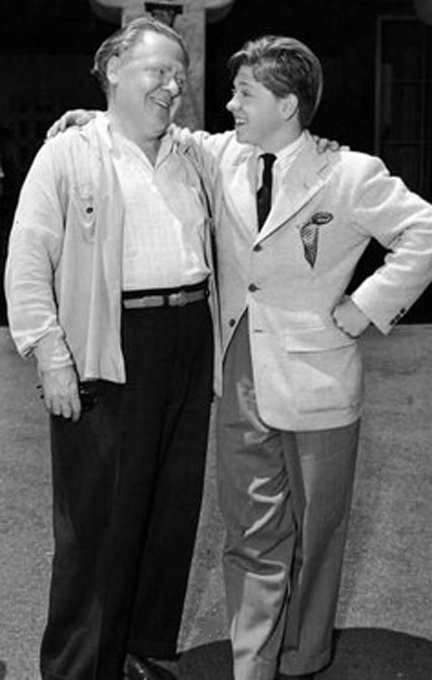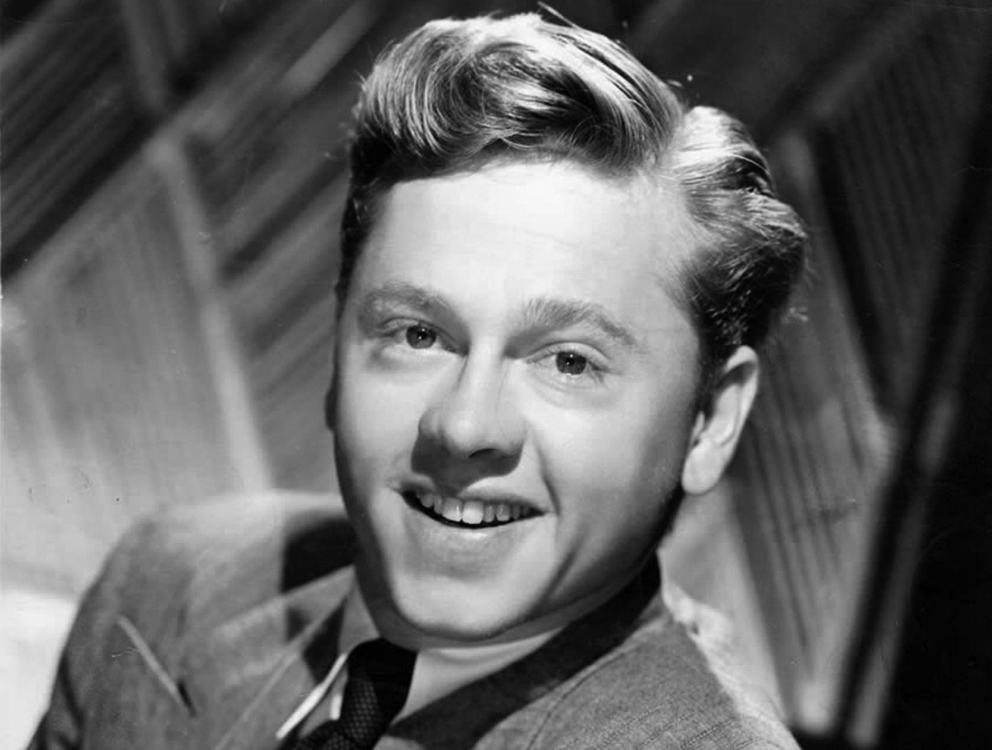|
Mickey Rooney - Scottish-American Actor
by Tom Doran
A great Hollywood star and international personality passed away recently - fondly remembered by fans primarily for his earlier sincere, but light-hearted MGM family films and musicals, he nevertheless stretched his talents to both stage and television, sometimes definitely discarding the pleasant facade that made him world famous and one of the highest paid actors of his day.
We are talking about Mickey Rooney - Scottish-American. Yes, you read right, Scottish-American - not the Irishman everyone thought he was by name, and perhaps looks.
Mickey Rooney was born Joseph Yule, Jr. - named after his father's stage name of Joseph Yule, Sr. Joseph senior was from Glasgow, Scotland- born in the Polmadie district of that city, with the given name of Ninian Joseph Ewell.

After emigrating to America, Ewell dropped Ninian as a first name - probably a good idea for a vaudeville star working the back-wood stages of America, and who undoubtedly had never heard the name before. Changing his last name to the Yule spelling also seemed appropriate (and probably easier to get the spelling right on the marquee); and Ewell is in fact one of the many phonetic variations of "Yule".
Ninian is the name of the Christian missionary to the Picts in days long gone and though not popular in the 19th century as a first name (if ever), it could be surmised his parents were religious and did so to honor their local Scottish saint.
Joe senior settled in Brooklyn, where his son, the soon to be famous Mickey Rooney was born. After a stint in vaudeville, with Joe Jr. part of the act before he was 2 years old, the family or least the mother - accounts vary - took the boy out west and thanks to his mother ended up in films. Joe Jr., in order to audition for a new series of films based on an Irish character called Micky McGuire, darkened his hair for the audition - which he soon got. Mickey soon became re-christened AS Mickey McGuire, mainly in a vain attempt to circumvent paying royalties to the owner/creator of the comic strip it was based on (figuring if that was his real name, he couldn't be sued or owe royalties). Needless to say that didn't work, but he got stuck with the name Mickey. In order to avoid any further lawsuits (which were threatened for use of the name), his last name finally evolved into Rooney (some say a variation of looney).
With a solid background in films as a featured performer, he soon worked his way up and was a very popular face. One early film was A Midsummer's Nights Dream - in which he played Puck. His performance, while certainly enthusiastic, is a bit over the top and a little of it goes a very long way.
Before long he was under contract to MGM - and gained enormous fame playing the good-natured son of the slightly stern, but eminently fair Judge Hardy. A long series in this role followed, and they were gigantic successes. Though the young Mickey was hardly the nice, considerate young man he portrayed in these films, he managed to keep most of that out of the public eye. He was apparently disliked by the crews that worked with him, mainly for his arrogant manner. But again, none of this hit the outside world at the time as the studios in general and MGM in particular were wildly (if not violently) protective of their money-making stars. Even Louis B. Mayor laid down the law to his young star at one point, with the threat of violence clearly intended to make its mark on the boy.
Mickey played a variety of roles, musicals, dramas such as a well-regarded role in Boys Town, sometimes as a wise-cracking little tough guy, but never an outright bad person (not at this point), as his roles were tightly controlled.
He developed a taste for pills, liquor and women at a very early age, and went through more marriages than any 3 men. His pills may have been the result of overwork, and some at MGM were notorious for doping their young stars so they could stay the course, do the work, stay slim. Judy Garland, Mickey's great friend and film co-star on many occasions, is one prime example. Also, sky-rocketing fame can do strange things to young people. His height never got above 5' 2", and this also may have had some effect on his demeanor. It's hard to say at this point as there is so much contrary information out there.

Mickey served in World War II, entertaining the troops in some dangerous war zones for which he was commended, but came home to a changed world, and far less important roles. He continued in some rare film musicals, and later on even played desperate gangsters and thugs.
He ventured into television, and stage - making various successful splashes over the decades in a huge variety of roles. No matter his ups or down, professional or private, he never stopped working - was never late for a job, nor did he ever fail to give his best. He was in fact working on a film in 2013, at the age of 93! A trooper to the end.
When all was said and done, he never made a big deal of his Scottish heritage, but was aware of it most certainly, and he would when asked mention it and his father's birthplace - even though his reddish-auburn hair and assumed name seemed to always peg him as an Irishman. While Rooney is certainly an Irish last name, the highest percentage of people with red-hair actually hail from Scotland.
He won't be remembered for his ethnic background, as it played little in his professional or private life (he seldom attempted accents in his films, and never successfully - and always seemed to be just "Mickey Rooney"), but he leaves an enormous legacy and a treasure trove of films, television and stage performances that will continue to be enjoyed and remembered for a very long time to come.
À phiob-mhòr - The Story of the Scottish Highland Bagpipe - Pamphlet
This is a fascinating history of the Bagpipe. From Ancient Egypt to China to Scandinavia to New Zealand, this very old instrument is a world traveler.
Explore the Gaelic names of all the parts of the Bagpipe. This paper also includes a discussion of "Piobaireachd" music and many other tidbits of information.
The pamphlet “À phiob-mhòr - The Story of the Scottish Highland Bagpipe” was written and illustrated by Angus MacPhee © 1970. It was printed by Eccles litho, North Church Place, Inverness and was published by An Comunn Gàidhealach with whose kind permission we publish it here.
These pamphlets have been scanned and therefore are large image files.
Click each link to read one page at a time
PAGE ONE
TABLE OF CONTENTS
PAGE THREE
|